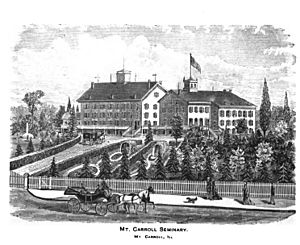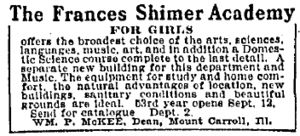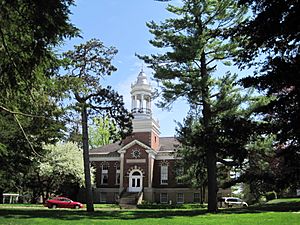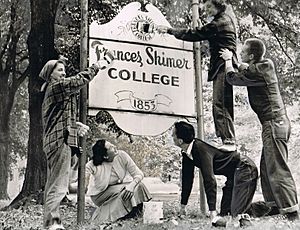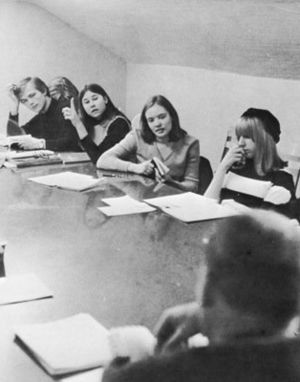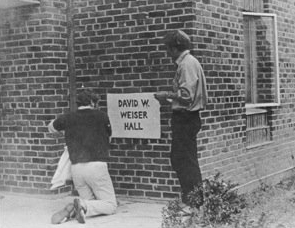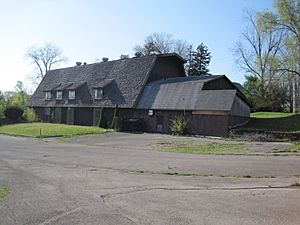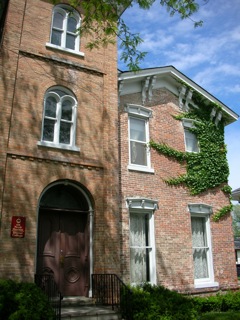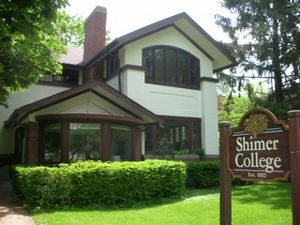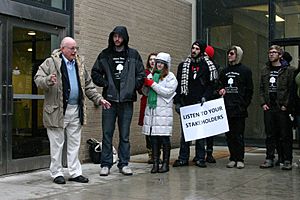History of Shimer College facts for kids
Shimer College was a special school that began in 1852 in a small town called Mt. Carroll, Illinois. At first, the town didn't have a public school, so they started the Mt. Carroll Seminary. It was a big challenge because they had no land, no teachers, and no money!
Over the years, Shimer College changed a lot. It started as a school for both boys and girls, then became a school just for women. Later, it grew into a college for women, and finally, it became a college for everyone again, focusing on "Great Books" – important classic texts.
Shimer College faced many tough times, like a phoenix that rises from its own ashes. There were times when the school almost closed, a big fire in 1906, and money problems. But students and teachers always worked together to keep the college going.
The school moved twice: first from Mount Carroll to Waukegan in 1978, and then to Chicago in 2006. In 2017, Shimer College joined North Central College and became the Shimer School of Great Books.
One unique thing about Shimer was how much students were involved in running the school. It also welcomed students who were ready to learn, even if they were younger than usual. Shimer always had very high academic standards, and its students often did very well on national tests and went on to graduate school.
| Name Changes | |
|---|---|
| 1853: | Mount Carroll Seminary |
| 1896: | Frances Shimer Academy of the University of Chicago |
| 1908: | Frances Shimer Academy and Junior College |
| 1910: | Frances Shimer School |
| 1932: | Frances Shimer Junior College |
| 1942: | Frances Shimer College |
| 1950: | Shimer College |
Contents
Starting the Mount Carroll Seminary
Shimer College began in Mount Carroll, Illinois, as the Mount Carroll Seminary. It was a school for both boys and girls, not connected to any specific church. The state of Illinois officially approved the school on June 18, 1852.
The town found two new teachers, Frances Wood and her friend Cindarella Gregory, who came from New York. Classes started on May 11, 1853, with just 11 students in one room of a church. By 1854, when the school opened its own building, there were 75 students!
At first, the school was supposed to be paid for by donations, but many people didn't keep their promises. In 1855, Frances Wood and Cindarella Gregory bought the school themselves. They promised to keep it open for at least 10 years. This showed how dedicated they were to education.
Throughout the 1800s, the school campus grew. When they needed to build more, Frances Wood, Cindarella Gregory, and even their students helped with the construction to save money. The campus was known for being very clean and healthy. By 1883, it covered a large area with many trees.
Music and art were very popular at the seminary. They had the first piano in the whole county! The music program started with only 3 students but quickly grew. By the 1880s, there were many music teachers and almost 40 instruments.
On December 22, 1857, Frances Wood married Henry Shimer, a local scientist. He also taught science at the school.
The Mount Carroll Seminary was like a prep school. Students could study for six years and then be ready for advanced college work. Some graduates were even able to skip the first years of college! The school also had special programs, like one that trained teachers and another that let students work to pay for their tuition.
The seminary welcomed anyone who wanted to learn, even children as young as three years old. After the Civil War in 1866, the school mostly focused on residential students who were women, though some men still attended classes during the day.
Frances Shimer was the main leader of the school from 1853 to 1896. She focused all her energy on making the school excellent, rather than trying to get more students or donations. In the 1880s, she tried to get money to help the school long-term, but it was difficult.
Joining the University of Chicago
On July 1, 1896, Frances Shimer gave control of the seminary to a group of trustees. The school then became connected with the University of Chicago. This meant the school, now called the Frances Shimer Academy of the University of Chicago, would follow the University of Chicago's high academic standards. However, the University of Chicago did not provide money.
After this, Frances Shimer retired because she was not well. She passed away in 1901. William Parker McKee became the new leader in 1897 and served until 1930. He, like many Shimer leaders, also taught classes.
Because of its connection to the University of Chicago, students from the academy were well-prepared for any university. The school was officially recognized by education groups in 1909.
In the late 1800s and early 1900s, more and more students enrolled. To make space, new buildings were constructed. But on February 9, 1906, a big fire destroyed many buildings, including the original ones. People quickly raised money to rebuild, and new, fireproof brick buildings were put up.
In 1909, a junior college program officially started. This meant the school offered two types of study: a four-year program like high school and a two-year college program. The school's name changed a few times, becoming "Frances Shimer Junior College" in 1932.
By the 1940s, the college faced problems with fewer students and money troubles. By 1949, only 65 students were enrolled, and the school was in debt.
Shimer College in Mount Carroll: New Beginnings
In 1950, a big change happened when Aaron Brumbaugh became president. He had been a dean at the University of Chicago. The school got its current name, "Shimer College," for the first time. It also welcomed both male and female students again and adopted the "Hutchins Plan," which focused on studying Great Books.
Around this time, Shimer was one of 12 colleges chosen for a special program. This program allowed high school students to start college early. It was very successful at Shimer and continued for many years, even after the special funding ended.
In 1954, Francis Joseph Mullin became president. He worked hard to raise money, tripling donations. Shimer became known as a place for serious learning. In the early 1960s, a magazine article called Shimer one of the best small liberal arts colleges in the U.S. for its "ideal intellectual climate."
Challenges and Changes
In the 1960s, more students than ever attended Shimer. But there were disagreements between the school's leaders and the students and younger teachers. Students felt that rules about dress and behavior were too strict.
In 1966 and 1967, the school went through a difficult time. The dean and younger teachers felt the president was making decisions without involving them. This led to protests and many teachers leaving the school. This period caused bad publicity and fewer new students.
In 1967, President Mullin resigned. Milburn Akers became the new president, followed by Robert Spencer Long.
Financial Difficulties and a Big Move
Student numbers kept falling in the late 1960s and early 1970s. By 1973, the school was deeply in debt. The leaders decided to close the school. Students protested, saying Shimer's education was unique and they had nowhere else to go. Students and teachers worked together to raise money, which kept the school open for a while.
However, financial problems continued. The Mount Carroll campus was too expensive to keep. In 1978, a sudden decision was made to move the school to Waukegan, Illinois. The school's belongings were moved in borrowed trucks during a huge snowstorm! The old Mount Carroll campus was sold. Even after the move, the college still had a lot of debt.
During these tough times, the whole Shimer community, including students, worked together to make decisions through a system called the "House," which was like a direct democracy.
Shimer College in Waukegan
Shimer College started classes in Waukegan in the spring of 1979 in an old Victorian house. At first, it had just one classroom building and one dorm. Over the years, it grew to 12 buildings.
The school kept its unique way of teaching in Waukegan. In 1981, they started a "Weekend College" program for adults who worked. This program allowed people to earn a bachelor's degree by attending classes every third weekend. Student numbers slowly increased. In 1988, Shimer even started offering a chess scholarship!
In Waukegan, the "House" system was replaced by a more organized "Assembly." This Assembly, inspired by the ideas of Jean-Jacques Rousseau, had committees with students, teachers, and staff working together. The president, Donald P. Moon, led the college from 1979 to 2004.
Money was still a challenge, and teachers sometimes didn't get paid much. But in the mid-1990s, the college began to improve its buildings, which helped the campus grow and look better.
In 2005, Shimer was invited to move to the Illinois Institute of Technology (IIT) campus in Chicago. After much discussion, the school's leaders decided to accept the invitation. The move to Chicago was completed on August 10, 2006.
Shimer College in Chicago and Beyond
In 2007, President William Craig Rice left Shimer. Thomas Lindsay became president in 2009, but his time was filled with disagreements. Students and teachers felt he wasn't respecting the school's tradition of self-governance.
In 2010, it was revealed that many of the trustees supporting Lindsay had financial ties to a major donor, Barre Seid. Despite strong opposition from teachers and students, the Board of Trustees approved changes to the school's mission statement. However, in April 2010, the Board voted to remove Lindsay as president.
Edward Noonan became interim president, followed by Susan Henking in 2012. She was the first female president since Frances Wood Shimer herself! Under Henking, Shimer worked more closely with community colleges and started a program called Shimer@60, offering free courses to Chicago residents aged 60 and over. She also helped Shimer make its final transition in 2017, becoming the Shimer Great Books School of North Central College.
Notable alumni
- Beulah Bondi, a famous actress who won awards, graduated from Shimer in 1907.



